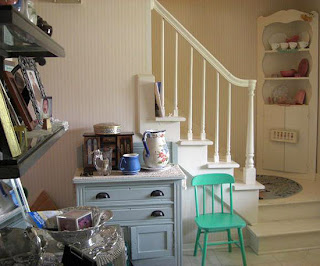We're so much better off than our ancestors. And I'm not just talking
about electricity, indoor plumbing, and penicillin. We're lucky that the
popularity of certain decorative items haven't survived . . . .
What is it?! It's a portion of a hair wreath.
Throughout history family members have preserved a lock of hair of a loved one, often following their death. In the mid 19th Century the custom took on a craft-like element by not just saving the hair in a locket but by weaving it into a keepsake.
 When Queen Victoria's husband, Albert, died in 1861, she had a piece of jewelry made from his hair which she wore until her death. The Queen's influence on fashion was profound and women throughout the world imitated her style. The popularity of hair ornamentation grew and lasted well into the 20th Century.
When Queen Victoria's husband, Albert, died in 1861, she had a piece of jewelry made from his hair which she wore until her death. The Queen's influence on fashion was profound and women throughout the world imitated her style. The popularity of hair ornamentation grew and lasted well into the 20th Century.
The circle of braided hair was made in remembrance
of a loved one who died on July 27th, 1866.
Like many art forms, hair mementos became more and more intricate.
Wire and beads were used in the weaving to create intricate designs.
My grandmother actually had a small wreath of her grandparents' hair
mounted in a shadow box. It hung on her bedroom wall and kind
of creeped me out when I was a kid. I never knew what happened
to it when she passed away. A family heirloom lost forever.
Hard to find outside of museums, hair wreaths were most often
created as part of a memorial, many times for a child. Seeing
one now makes me sad for the parents.
Unlike other types of antiques, hair wreaths are
not easily duplicated. If you run across one, it's most likely authentic. Quite fragile, few survive today and those that do are usually pricey.
If you're out flea-marketing this weekend, keep an eye out for antique hair ornaments and wreaths. Maybe it's a tradition that shouldn't have faded away. . . . .











.png)





































